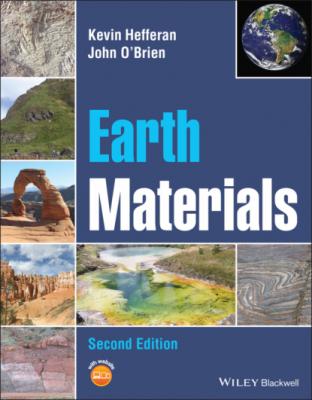Earth Materials. John O'Brien
Читать онлайн.| Название | Earth Materials |
|---|---|
| Автор произведения | John O'Brien |
| Жанр | География |
| Серия | |
| Издательство | География |
| Год выпуска | 0 |
| isbn | 9781119512219 |
Figure 4.11 Relationship between (a) atomic packing, (b) a unit cell, and (c) octahedral coordination polyhedra in halite (NaCl).
Source: Wenk and Bulakh (2016). © Cambridge University Press.
Figure 4.12 The 14 Bravais lattices and the six (or seven) crystal systems they represent.
Source: Courtesy of Steve Dutch.
Table 4.4 Major characteristics of Bravais lattice cells in the major crystal systems.
| Crystal system | Unit cell edge lengths | Unit cell edge intersection angles | Bravais lattice types |
|---|---|---|---|
| Isometric (cubic) | (a = b = c) Preferred format for edges of equal length is (a1 = a2 = a3) | α = β = γ = 90° | Primitive (P) Body centered (I) Face centered (F) |
| Tetragonal | (a1 = a2 ≠ a3) or a = b ≠ c | α = β = γ = 90° | Primitive (P) Body centered (I) |
| Hexagonal (hexagonal) | (a1 = a2 ≠ c) (a = b ≠ c) | (α = β = 90o ≠ γ = 120°) | Primitive (P) |
| Hexagonal (trigonal or rhombohedral) | (a1 = a2 = a3) | α = β = γ ≠ 90° | Primitive (P) |
| Orthorhombic | a ≠ b ≠ c | (α = β = γ = 90°) | Primitive (P) Body centered (I) End centered (A, B, C) Face centered (F) |
| Monoclinic | a ≠ b ≠ c | (α = γ = 90° ≠ β) | Primitive (P) End centered (C) |
| Triclinic | a ≠ b ≠ c | (α, β, and γ ≠ 90°) | Primitive (P) |
4.5 CRYSTAL SYSTEMS
Imagine yourself, if you can, the crystals on a web site, in a mineral shop or a museum. Such crystals are partially or completely bounded by planar crystal faces that are produced when minerals grow. Many other mineral specimens are partially or completely bounded by flat, planar cleavage faces produced when minerals break along planes of relatively low total bond strength. The shapes of the crystals,
